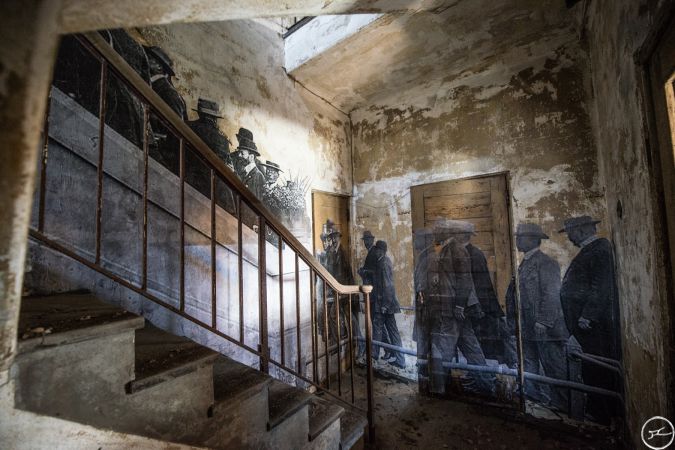
An image from JR’s “Unframed — Ellis Island.” Photo: Courtesy of JR
The past two weeks have been busy for the members of the TED community. Some news highlights:
Artist JR is bringing the past back to life with his new series “Unframed.” He has taken archival photos of the Ellis Island Immigrant Hospital in New York, closed since 1954, and pasted them up so that doctors who worked there appear to float in the surgical theater and kids treated there peer in through a window. “I let the walls decide what part of the image should appear,” he tells The New York Times. (Watch JR’s TED Talk, “Use art to turn the world inside out.”)
The United States Food and Drug Administration is holding a conference to talk about cybersecurity on medical devices — in other words, can you hack a pacemaker? (Yes.) It starts October 21 in Arlington, Virginia and is open to the public, according to The Washington Post. (Watch Avi Rubin’s talk, “All your devices can be hacked.”)
Gregoire Courtine and his team have released a new paper. The paralyzed rats he was working with? The little guys are now taking 1,000 successive steps without failure. “It is a little bit Frankenstein,” he tells the MIT Technology Review. (Watch Gregoire’s talk, “The paralyzed rat that walked.”)
Lewis Pugh shared with The New York Times what he did and didn’t see while swimming long tracts through the Seven Seas this summer. “When I swam in the Aegean, the sea floor was covered with litter; I saw tires and plastic bags, bottles, cans, shoes and clothing,” he says. “I saw no sharks, no whales, no dolphins. I saw no fish longer than 11 inches.” (Watch Lewis’ TED Talk, “My mind-shifting Everest swim.”)
Carl Zimmer opened the 7th annual Imagine Science Film Festival. (Watch Carl’s TED-Ed lesson, “How did feathers evolve?“)
NASA is partnering with Elon Musk’s SpaceX, as well as with Boeing, to create “space taxis.” These taxis will take astronauts to the International Space Station. (Watch Elon’s Q&A, “The man behind Tesla, SpaceX, SolarCity.”)
Amy Cuddy and power posing—the phenomenon of her creation—gets a profile in The New York Times Fashion & Style section. The piece runs down how Cuddy’s advice to strike a powerful stance for two minutes has had a ripple effect through the world. (Watch Amy’s talk, “Your body language shapes who you are,” or check out our piece, “Amy Cuddy power-poses through popular culture.”
Thomas Goetz and his healthcare startup, Iodine, have launched their consumer-friendly online database of prescription drugs. Goetz talks to The New York Times about how the service incorporates ratings on how people feel about the product, using information from Google Consumer Surveys. (Watch Thomas’ TED Talk, “It’s time to redesign medical data” or read our update with him: “What are your drugs trying to tell you?”)
Paleontologist Zeresenay Alemseged stars in this Nautilus profile of Ethiopia’s field researchers — an international group investigating humanity’s origins, with more than a little Indiana Jones flair. (Watch Zeresenay’s talk, “The search for humanity’s roots.”)
Charmian Gooch’s work at Global Witness gets a mention in a Washington Post story about how anonymous companies make it difficult for law enforcement to investigate crimes. (Watch Charmian’s TED Talk, “My wish: To launch a new era of open business.”)
Sally Kohn makes the Advocate’s list of the top 50 most influential LGBT people in media. (Watch Sally’s talks, “Let’s try emotional correctness” and “Don’t like clickbait? Don’t click.”)
Leslie Morgan Steiner penned a piece for The Washington Post titled “He held a gun to my head. And I love him.” It’s her explanation of why the notions that Janay Palmer Rice should just leave her husband are too simplistic. (Watch Leslie’s TED Talk, “Why domestic violence victims don’t leave.”)
Architect Bradley Cantrell, one of our TEDGlobal 2014 Fellows, creates landscapes that react in real time. Fast Company’s Co.Exist takes a look at his concepts, which could lead to levees that adapt to the needs of the river and parks that actively improve air quality. (Read about Bradley and the new class of TED Fellows.)
Recovers.org, the disaster response system created by Morgan and Caitria O’Neill, is being deployed in Weed, California, where wildfires have forced more than 2,000 residents to evacuate. (Watch Morgan and Caitria’s talk, “How to step up in the face of disaster.”)
Noah Wilson-Rich asks in The New York Times: “Are bees back up on their knees?” (Watch Noah’s TED Talk, “Every city needs healthy honey bees.”)
And finally, cool news for Sylvia Earle, who wished in 2009 for more ocean “hope spots.” Barack Obama is broadening the Pacific Remote Islands National Marine Monument from less than 100,000 square miles to close to 500,000 square miles. This is in addition to the nearly 700,000 square miles he pledged to protect in June. (Watch Sylvia’s talk, “My wish: Protect our oceans.”)
Comments (1)